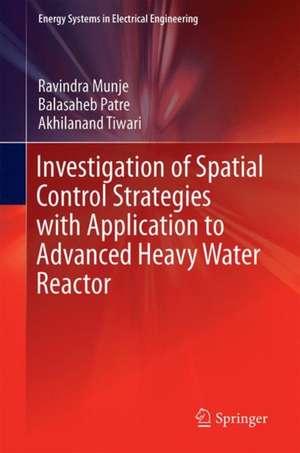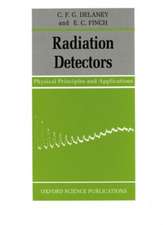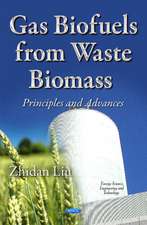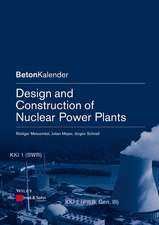Investigation of Spatial Control Strategies with Application to Advanced Heavy Water Reactor: Energy Systems in Electrical Engineering
Autor Ravindra Munje, Balasaheb Patre, Akhilanand Tiwarien Limba Engleză Hardback – 23 oct 2017
| Toate formatele și edițiile | Preț | Express |
|---|---|---|
| Paperback (1) | 550.07 lei 38-44 zile | |
| Springer Nature Singapore – 25 aug 2018 | 550.07 lei 38-44 zile | |
| Hardback (1) | 641.71 lei 6-8 săpt. | |
| Springer Nature Singapore – 23 oct 2017 | 641.71 lei 6-8 săpt. |
Din seria Energy Systems in Electrical Engineering
- 15%
 Preț: 643.34 lei
Preț: 643.34 lei - 15%
 Preț: 640.06 lei
Preț: 640.06 lei - 18%
 Preț: 1404.46 lei
Preț: 1404.46 lei - 24%
 Preț: 786.73 lei
Preț: 786.73 lei - 24%
 Preț: 967.60 lei
Preț: 967.60 lei - 20%
 Preț: 572.59 lei
Preț: 572.59 lei - 20%
 Preț: 552.18 lei
Preț: 552.18 lei - 18%
 Preț: 944.99 lei
Preț: 944.99 lei - 18%
 Preț: 1108.36 lei
Preț: 1108.36 lei - 18%
 Preț: 727.18 lei
Preț: 727.18 lei - 18%
 Preț: 959.19 lei
Preț: 959.19 lei - 18%
 Preț: 892.90 lei
Preț: 892.90 lei - 15%
 Preț: 659.02 lei
Preț: 659.02 lei - 15%
 Preț: 638.24 lei
Preț: 638.24 lei - 15%
 Preț: 643.84 lei
Preț: 643.84 lei - 15%
 Preț: 644.63 lei
Preț: 644.63 lei - 24%
 Preț: 1865.59 lei
Preț: 1865.59 lei - 18%
 Preț: 722.75 lei
Preț: 722.75 lei - 20%
 Preț: 464.00 lei
Preț: 464.00 lei - 15%
 Preț: 634.18 lei
Preț: 634.18 lei - 20%
 Preț: 543.69 lei
Preț: 543.69 lei - 18%
 Preț: 736.64 lei
Preț: 736.64 lei - 18%
 Preț: 889.29 lei
Preț: 889.29 lei - 18%
 Preț: 777.20 lei
Preț: 777.20 lei - 18%
 Preț: 1123.35 lei
Preț: 1123.35 lei - 18%
 Preț: 782.69 lei
Preț: 782.69 lei - 15%
 Preț: 602.42 lei
Preț: 602.42 lei
Preț: 641.71 lei
Preț vechi: 754.95 lei
-15% Nou
Puncte Express: 963
Preț estimativ în valută:
122.83€ • 133.47$ • 103.24£
122.83€ • 133.47$ • 103.24£
Carte tipărită la comandă
Livrare economică 21 aprilie-05 mai
Preluare comenzi: 021 569.72.76
Specificații
ISBN-13: 9789811030130
ISBN-10: 9811030138
Pagini: 180
Ilustrații: XXVII, 168 p. 79 illus., 69 illus. in color.
Dimensiuni: 155 x 235 mm
Greutate: 0.45 kg
Ediția:1st ed. 2018
Editura: Springer Nature Singapore
Colecția Springer
Seria Energy Systems in Electrical Engineering
Locul publicării:Singapore, Singapore
ISBN-10: 9811030138
Pagini: 180
Ilustrații: XXVII, 168 p. 79 illus., 69 illus. in color.
Dimensiuni: 155 x 235 mm
Greutate: 0.45 kg
Ediția:1st ed. 2018
Editura: Springer Nature Singapore
Colecția Springer
Seria Energy Systems in Electrical Engineering
Locul publicării:Singapore, Singapore
Cuprins
Chapter 1: Introduction.- Chapter 2: Modelling and Control of Advanced Heavy Water Reactor.- Chapter 3: State Feedback Control for AHWR.- Chapter 4: Sliding Mode Control for Spatial Stabilization of AHWR.- Chapter 5: Spatial Control of AHWR using Fast Output Sampling Technique.- Chapter 6: Periodic Output Feedback for Spatial Control of AHWR: A Three-Time-Scale Approach.- Chapter 7: Discrete-time Sliding Mode Spatial Control of AHWR.- Chapter 8: Comparison of Spatial Controllers.- Chapter 9: Conclusions and Future Scopes.- Appendix A.- Appendix B.- Bibliography.
Notă biografică
Ravindra K. Munje was born in Mangrulpir, India, in 1983. He received his B.E. degree in Electrical Engineering from Mumbai University in 2005, his M.E. degree in Electrical Engineering from Pune University in 2009, and his Ph.D. in Electrical Engineering from Swami Ramanand Teerth Marathwada University, Nanded in 2015. He has published around 30 papers in national and international conferences and journals. He is a life member of ISTE and the Institution of Engineers (India), and a member of the IEEE and IET. His areas of interest include modeling of large-scale systems and design of controllers based on modern control techniques such as multirate output feedback (like fast output sampling and periodic output feedback), singular perturbation techniques, and sliding mode control. At present, he is working as an associate professor at the Electrical Engineering Department of K.K. Wagh Institute of Engineering Education and Research, Nashik.
Balasaheb M. Patre received B.E. and M.E. degrees in Instrumentation and Control Engineering from Marathwada University, Aurangabad in 1986 and 1990, respectively and a PhD. in Systems and Control Engineering from the Indian Institute of Technology Bombay in 1998. He has published around 160 papers in international journals and conferences. He has presented his research work at Cambridge University, UK, and in Germany. He is a life member of ISTE and the Instrument Society of India, a member of IETE, and a senior member of the IEEE and IET. He is a reviewer for several international Journals. His areas of interest include sliding mode control and its applications, robust control, large-scale systems, interval arithmetic applications, intelligent control, etc. At present, he is working as a Professor of Instrumentation Engineering at the SGGS Institute of Engineering and Technology, Nanded, India.
Dr. A P Tiwari joined BARC through the 28th batch of BARC training school. He completed his BSc in Electrical Engineering from Aligarh Muslim University in 1984 and his PhD in Systems and Control Engineering at IIT Bombay in 2000. During his early career at BARC, he worked on control analysis of the Dhruva reactor and control system design of the Purnima-III U-233 fuelled reactor. From 1995–2002, he worked on the development of the Liquid Zone Control System for the 540 MWe PHWR. He was also responsible for the design of process control and instrumentation systems and control algorithms for AHWR. His research areas include time-scale and singular perturbation methods in control, multivariable control, and sliding mode control with application to nuclear reactors. He has guided a number of PhD and MTech students at IIT Bombay and HBNI and is actively involved in research in the area of modern control systems design for large reactors, namely PHWR and AHWR. He received the DAE Science and Technology Award in 2003 and Group Achievement Awards in 2006, 2012 and 2013 for his various activities. He also received the HBNI Distinguished Faculty Award in 2015.
Balasaheb M. Patre received B.E. and M.E. degrees in Instrumentation and Control Engineering from Marathwada University, Aurangabad in 1986 and 1990, respectively and a PhD. in Systems and Control Engineering from the Indian Institute of Technology Bombay in 1998. He has published around 160 papers in international journals and conferences. He has presented his research work at Cambridge University, UK, and in Germany. He is a life member of ISTE and the Instrument Society of India, a member of IETE, and a senior member of the IEEE and IET. He is a reviewer for several international Journals. His areas of interest include sliding mode control and its applications, robust control, large-scale systems, interval arithmetic applications, intelligent control, etc. At present, he is working as a Professor of Instrumentation Engineering at the SGGS Institute of Engineering and Technology, Nanded, India.
Dr. A P Tiwari joined BARC through the 28th batch of BARC training school. He completed his BSc in Electrical Engineering from Aligarh Muslim University in 1984 and his PhD in Systems and Control Engineering at IIT Bombay in 2000. During his early career at BARC, he worked on control analysis of the Dhruva reactor and control system design of the Purnima-III U-233 fuelled reactor. From 1995–2002, he worked on the development of the Liquid Zone Control System for the 540 MWe PHWR. He was also responsible for the design of process control and instrumentation systems and control algorithms for AHWR. His research areas include time-scale and singular perturbation methods in control, multivariable control, and sliding mode control with application to nuclear reactors. He has guided a number of PhD and MTech students at IIT Bombay and HBNI and is actively involved in research in the area of modern control systems design for large reactors, namely PHWR and AHWR. He received the DAE Science and Technology Award in 2003 and Group Achievement Awards in 2006, 2012 and 2013 for his various activities. He also received the HBNI Distinguished Faculty Award in 2015.
Textul de pe ultima copertă
This book examines the different spatial control techniques for regulation of spatial power distribution in advanced heavy water reactors (AHWR). It begins with a review of the literature pertinent to the modeling and control of large reactors. It also offers a nodal-core model based on finite difference approximation since the AHWR core is considered to be divided into 17 relatively large nodes. Further, it introduces a nonlinear model characterizing important thermal hydraulics parameters of AHWR and integrates it into the neutronics model to obtain a coupled neutronics-thermal hydraulics model of AHWR. The book also presents a vectorized nonlinear model of AHWR and implements it in MATLAB/Simulink environment. The model of the reactor is then linearized at the rated power and put into standard state variable form. It is characterized by 90 states, 5 inputs and 18 outputs. Lastly, it discusses control techniques for a nonlinear model of AHWR. This book will prove to be a valuable resource for professional engineers and implementation specialists, researchers and students.
Caracteristici
Presents recent research on modeling and control of large nuclear reactors Includes control scheme representations to enable a quick understanding of control techniques Compares control techniques to help readers understand different model order reduction methods Includes supplementary material: sn.pub/extras












